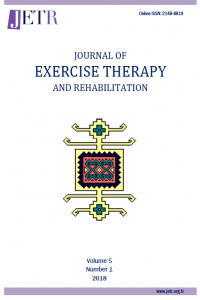Adölesan diparetik ve hemiparetik serebral palsililerde dinamik denge ve vücut kütle indeksi ile ilişkisi
Abstract
Amaç: Adölesan hemiparetik ve diparetik serebral palsili (SP) gruplar arasında dinamik denge yönünden farklılığı araştırmak ve denge ile vücut kütle indeksi(VKİ) ilişkisini saptamaktır.
Yöntem: Çalışmamıza yaş ve cinsiyet bakımından benzer olan 12-18 yaş aralığındaki 21 hemiparetik SP’li, 19 diparetik SP’li, 26 sağlıklı adölesan alındı. Bireylerin sosyodemografik bilgileri kişisel bilgi formunda kaydedildi ve dinamik denge değerlendirmesi için ise zamanlı kalk yürü testi (ZKY testi) kullanıldı.
Bulgular: Yapılan çalışmada hemiparetikler ve diparetik adölesanlar arasında hamilelikte geçirilen hastalıklar, hamilelikte sigara ve ilaç kullanımı, doğum şekli, tek/çoğul gebelik, doğum sırasında komplikasyonlar, postnatal diğer özellikler, yaş, boy, kilo, vücut kütle indeksi gibi değişkenler açısından fark bulunmadı (p˃0,05). Çalışmamızda sağlıklı adölesanlar, hemiparetikler ve diparetikler SP’li adölesanların ZKY skorları yönünden en iyi sonuçlar sağlıklılarda elde edildi ve üç grup arasında bu skorlar arasında fark bulundu (p<0,001). Hemiparetik adölesanların ZKY testi skorları ise diparetiklere göre düşük bulundu (p<0,05). Ayrıca sağlıklı adölesanlar, hemiparetik ve diparetik SP’li adölesanlarda ZKY ile VKİ arasında fark bulunmadı (p>0,05).
Tartışma: Serebral palsili adölesanlarda denge problemleri fonksiyonel motor aktiviteleri, yürüyüşü ve günlük yaşam aktivitelerini olumsuz yönde etkilemektedir. Araştırmaya dâhil edilen gruplardan ZKY testi skorları en iyi olan grup sağlıklı adölesanlar sonrasında ise hemiparetik SP’lilerdir. Çalışmamız, SP tiplerinden hemiparetik ve diparetik adölesanlar ile sağlıklı bireylerin dinamik dengeleri arasındaki ilişkiyi göstermesi bakımından önemlidir.
References
- 1. Özal C, Kerem Günel M. Spastik serebral palsili çocuklarda gövde kontrolü ile fonksiyonel mobilite ve denge arasındaki ilişkinin incelenmesi. J Exerc Ther Rehabil. 2014;1:1-8.
- 2. Mutlu A, Piştav Akmeşe P, Kerem Günel M. Değişik özür seviyesindeki serebral palsili çocukların annelerinin depresyon düzeyleri farklı mıdır? Yeni Tıp Dergisi. 2010;27:87-92.
- 3. Arneson CL, Durkin MS, Benedict RE, et al. Prevalence of cerebral palsy: Autism and Developmental Disabilities Monitoring Network, three sites, United States. 2004. Disabil Health J. 2009;2:45-48.
- 4. Bhasin T, Brocksen S, Nonkin Avchen R, et al. Prevalence of four developmental disabilities among children aged 8 years - Metropolitan Atlanta Developmental Disabilities Surveillance Program, 1996 and 2000. MMWR Surveill Summ. 2006;55:1-9.
- 5. Paneth N, Hong T, Korzeniewski S. The descriptive epidemiology of cerebral palsy. Clin Perinatol. 2006;33:251-267.
- 6. Johnson A. Prevalence and characteristics of children with cerebral palsy in Europe. Dev Med Child Neurol. 2002;44:633-640.
- 7. Winter S, Autry A, Boyle C, et al. Trends in the prevalence of cerebral palsy in a populationbased study. Pediatrics. 2002;110:1220-1225.
- 8. Serdaroğlu A, Cansu A, Ozkan S, et al. Prevalence of cerebral palsy in Turkish children between the ages of 2 and 16 years. Dev Med Child Neurol. 2006;48:413-416.
- 9. Shumway-Cook A, Hutchinson S, Kartin D, et al. Effect of balance training on recovery of stability in children with cerebral palsy. Dev Med Child Neurol. 2003;45:591-602.
- 10. Kenis-Coskun O, Giray E, Eren B, et al. Evaluation of postural stability in children with hemiplegic cerebral palsy. J. Phys. Ther. Sci. 2016;28:1398-1402.
- 11. Woollacott HW, Shumway-Cook A. Postural Dysfunction During Standing and Walking in Children with Cerebral Palsy: What Are the Underlying Problems and What New Therapies Might Improve Balance? Neural Plasticity. 2005;12:211-219.
- 12. Williams EN, Carroll SG, Reddihough DS. Investigation of the timed ‘up & go’ test in children. Dev Med Child Neurol. 2005;47:518-524
- 13. Katz-Laurer M, Rotem H, Keren O. Balance abilities and gait characteristics in post traumatic brain injury, cerebral palsy and typically developing children. Dev Neurorehabil. 2009;12:100-105.
- 14. Styer-Acevedo J. Physical therapy for the child with cerebral palsy. In: Pediatric Physical Therapy. Tecklin JS (Ed). 3rd ed. Philadelphia: Lippincott Williams & Wilkins; 1999:107-162.
- 15. Palisano R, Rosenbaum P, Backett P, et al. Gross Motor Function Classification System Expended and Revised [Kaba Motor Fonksiyon Sınıflandırma Sistemi Genişletilmiş ve Yeniden Düzenlenmiş Şekli (Kerem Günel M, Mutlu A, Livanelioğlu A, El Ö, Baydar M, Peker Ö, vd. Çev)]. Dev Med Child Neurol. 2007;39:214-223.
- 16. Podsiadlo D, Richardson S. The Timed ”Up & Go”: A test of basic functional mobility for frail elderly persons. J Am Geriatr Soc. 1991;39:142-148.
- 17. Nicolini-Panisson D, Donadio MV. Timed “Up & Go” test in children and adolescents. Rev Paul Pediatr. 2013;31:377-383.
- 18. Dhote SN, Khatri PA, Ganvir SS. Reliability of “Modified timed up and go” test in children with cerebral palsy. J Pediatr Neurosci. 2012;7:96-100.
- 19. Williams EN, Carroll SG, Reddihough DS, et al. Investigation of the timed ‘up & go’ test in children. Dev Med Child Neurol. 2005;47:518-524.
- 20. Ziano CA, Marchese VG, Westcott SL. Timed up and down stairs test: preliminary reliability of a new measure of functional mobility. Pediatr Phys Ther. 2004;16:90-98.
Details
| Primary Language | Turkish |
|---|---|
| Journal Section | Articles |
| Authors | |
| Publication Date | June 4, 2018 |
| Submission Date | August 2, 2017 |
| Published in Issue | Year 2018 Volume: 5 Issue: 1 |

